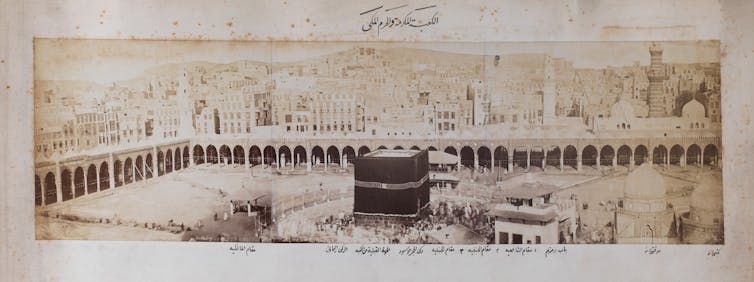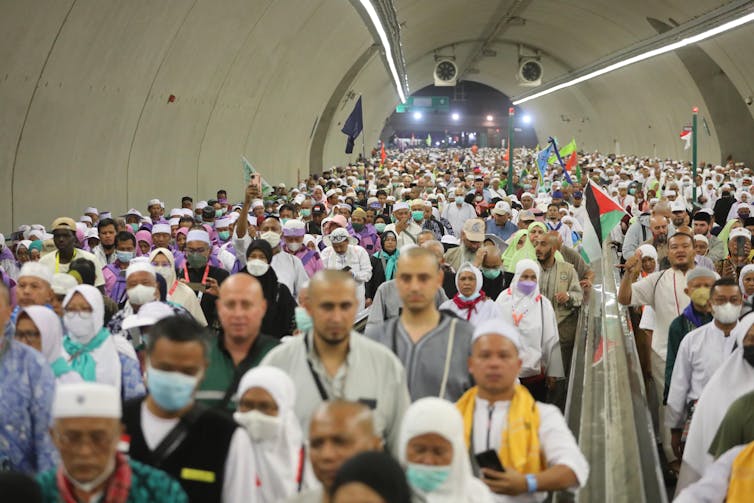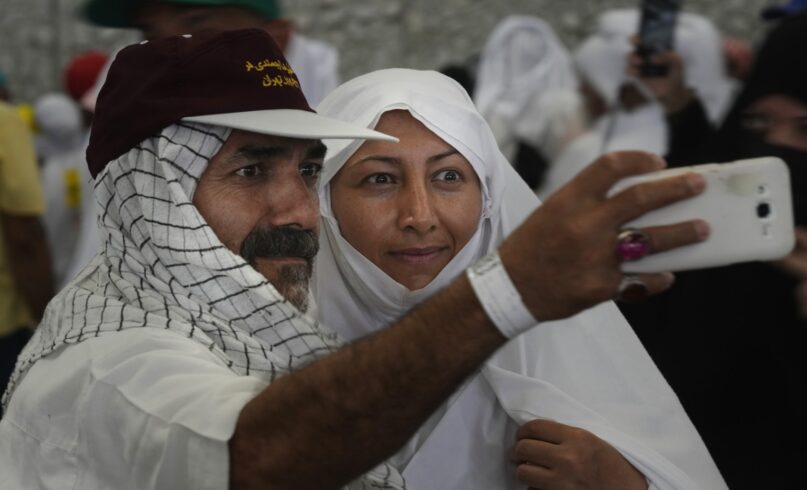(The Conversation) — The hajj – the annual Islamic pilgrimage to Mecca, Saudi Arabia, which Muslims are expected to make once in their lives if they are able – is expected to begin June 26 and last for five days. In 2023, approximately 2 million pilgrims will participate, close to the annual numbers of pilgrims in years before the COVID-19 pandemic.
Their visits, like those in generations past, will be enhanced, and even made possible, by modern technology.
In recent years, the Saudi government has developed smartphone apps aimed at organizations of pilgrim groups. Pilgrims use apps themselves, with guides to help them find and pray at specific holy locations. And they document their journey, both physical and spiritual, on social media platforms like Instagram and TikTok.
The country is rolling out smart cards for pilgrims to access hajj services and information, as well as make cashless payments.
And in 2022, the Saudi government established an online system by which prospective pilgrims from the U.S., Australia and Western Europe must enter a digital lottery for visas allowing them to make the hajj. As for Muslim-majority countries, one visa is allocated per 1,000 Muslims in each country. Those who are granted visas must book their travel through the Saudi government, rather than through travel agencies in their home countries.
As those changes have occurred, news coverage about the hajj has often mentioned the technology involved, describing it as a new phenomenon that is “transforming” the pilgrimage.
Yet as a historian of the Middle East and an expert on contemporary Islam, I know that technology has been at the heart of the hajj since the mid-1800s. Transportation and communications technologies have long been fundamental to governments’ management of the pilgrimage and to pilgrims’ spiritual experiences.
Travel technology
As far back as the 1850s, steamship technology made it possible for many more Muslims to make the pilgrimage even if they lived long distances from Mecca.
According to scholar Eric Schewe, “European shipping lines sought Hajj pilgrims as passengers to supplement” the money they made from shipping commercial cargo through the Suez Canal. By dropping off pilgrims at Arabian ports along a route their ships were already traveling, merchants were able to make a little extra income around the time of the hajj.
And the pilgrims appreciated the safety, speed, reliability and lower cost of steamship travel. As a result, they could reach the hajj more quickly and more cheaply than at any earlier period in history. From the 1880s to the 1930s, the number of pilgrims going on hajj each year quadrupled.
While steamships helped those traveling by water, rail helped those coming by land – especially those from Russia, whose multi-leg journeys often included travel by train to Odessa, in today’s Ukraine, or another Black Sea port, where they crossed to Istanbul by steamship and then to Mecca via caravan.

‘The honoured Ka‘bah and the Meccan sanctuary,’ 1880 photography by Sadiq Bey.
Khalili Collections via Wikimedia Commons, CC BY-SA
Communications technology
The telegraph also played an important role in the hajj. The Ottoman government used its extensive telegraph network to govern and as a sign of independence from European powers; one key link was from the capital in Istanbul through Damascus, Syria, to Mecca. European consular officials, rail and steamship companies and even individual pilgrims used the telegraph system for hajj-related communications.
Other communications technologies also affected the pilgrimage. Colonial powers with Muslim populations worried that the mass gathering of Muslims would lead to political unrest. They also worried about public health.
The speed of rail and steam travel meant that pilgrims could bring infectious diseases home with them, as happened with the cholera epidemics that broke out regularly during the hajj in the 1800s.
Many governments introduced tracking regulations that relied on print technologies: The Dutch in 1825 began requiring pilgrims to get passports, while the French in 1892 began requiring Algerian pilgrims to have travel permits. The British government in 1886 gave travel agency Thomas Cook an exclusive contract for hajj travel from India, requiring pilgrims to pre-purchase tickets for each leg of the journey.
Together, these regulations helped pilgrims get through the hajj safely. But they also worked to minimize its potential political and public health risks for the colonial powers that governed most of the world’s Muslim population.
Into the modern era
The spread of commercial air travel starting in the 1940s changed hajj dynamics further: Flying was even faster, cheaper and safer than steamship travel. It offered to further open hajj participation to more Muslims, but created massive logistical, political and economic challenges as the number of pilgrims increased six or seven times between 1950 and 1980.
New communications technologies further popularized the hajj. For example, radio stations covered the hajj, starting in the 1940s in Mandate Palestine, with pilgrim letters broadcast to listeners at home. Like earlier cinema newsreels, television from the 1960s showed viewers footage of pilgrims circumambulating or walking around the Kaaba, one of the key hajj rituals. This footage helped inspire them to want to go on hajj as well.
Meanwhile, growing literacy rates allowed Muslims to read the increasing number of printed hajj guides helping them navigate lodging, eating and worship. Contemporary hajj travelogues recording pilgrims’ experiences are part of a classical genre of Middle Eastern travel literature, known in Arabic as the rihla or seyahetname; both terms describe books of travels that typically included pilgrimage.
As pilgrims celebrated their ability to travel to the hajj via airplane, glitches happened. In 1952, the Saudi government’s last-minute cutting a hajj entry tax encouraged thousands of additional pilgrims to fly to Beirut, where Lebanese airline companies had no seats available. Instead, the United States Air Force organized an airlift that transported nearly 4,000 stranded pilgrims from Beirut to Mecca in time to make the hajj.
Again, communications technologies played an important role in pilgrim management. In the 1950s, British-governed Malaysia issued so-called “pilgrim passports,” which collected all information relevant to a pilgrim’s travel, from vaccination dates to next of kin contact information. Saudi-issued hajj visas evolved from handwritten and handstamped in the 1970s to digitally stamped, bar-coded visas by the late 2000s.

Massive numbers of people make the hajj every year, requiring significant effort for crowd control and safety.
Ashraf Amra/Anadolu Agency via Getty Images
Large numbers of travelers
Historically, a tiny minority of Muslims envisioned making the pilgrimage at any point in their lives. Even today, most Muslims will never be able to go on hajj, and most who do will go only once.
But the global Muslim population numbers just over 2 billion, so even a small fraction of their total means a lot of people. The 2 million expected on this year’s hajj are still just 0.1% of the world’s Muslims.
With travel and communications eased, Mecca’s ability to handle all those visitors at once has become the major challenge. The stakes are high for the Saudi Ministry of Hajj and Umrah: It is expected to provide a safe, healthy and spiritually meaningful experience for all pilgrims, while avoiding any bad press for the host country. Umrah, known as the “lesser pilgrimage”, is recommended but not required for Muslims. It includes many of the hajj rituals but can be completed at any time of the year.
Now, with its own digital tools and devices in the hands of many pilgrims, the 21st century hajj fits within the longer history of technology and the hajj, a story nearly 200 years old. Even as the specific technologies have changed, their importance to the management of the hajj and to pilgrims’ spiritual experiences remains constant.
(Andrea Stanton, Associate Professor of Islamic Studies & Faculty Affiliate, Center for Middle East Studies, University of Denver. The views expressed in this commentary do not necessarily reflect those of Religion News Service.)
![]()





